 In delivering his Budget on 22 November, Philip Hammond reported that the independent Office for Budget Responsibility had revised down its forecasts of growth in productivity and real GDP, and hence of earnings growth.
In delivering his Budget on 22 November, Philip Hammond reported that the independent Office for Budget Responsibility had revised down its forecasts of growth in productivity and real GDP, and hence of earnings growth.
Today, median earnings are £23,000 per annum. This is £1500 less than the £24,500 that the median worker earned in 2008 in today’s prices. The OBR forecasts a growth in real household disposable income of just 0.35% per annum for the next four years.
With lower growth in earnings would come a lower growth in tax revenues. With his desire to cut the budget deficit and start eventually reducing government debt, this would give the government less scope for spending on infrastructure, training and other public-sector investment; less scope to support public services, such as health and education; less scope for increasing benefits and public-sector wages.
The normal measure of productivity, and the one used by the OBR, is the value of output produced per hour worked. This has hardly increased at all since the financial crisis of 2008. It now takes an average worker in the UK approximately five days to produce the same amount as it takes an average worker in Germany four days.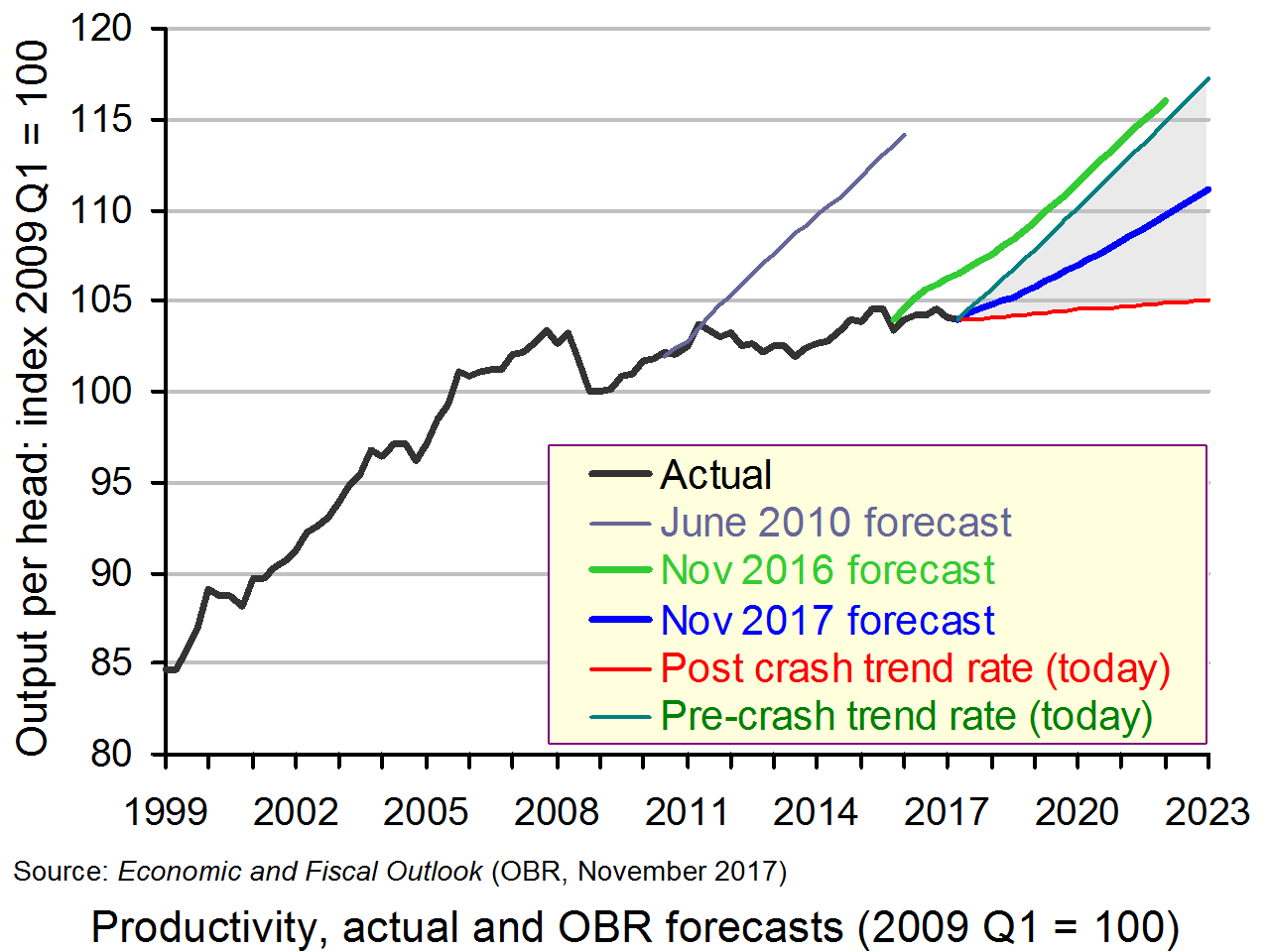 Although other countries’ productivity growth has also slowed since the financial crisis, it has slowed more in the UK and from a lower base – and is now forecast to rebound less quickly.
Although other countries’ productivity growth has also slowed since the financial crisis, it has slowed more in the UK and from a lower base – and is now forecast to rebound less quickly.
For the past few years the OBR has been forecasting that productivity growth would return to the trend rate of just over 2% that the UK achieved prior to 2008. For example, the forecasts it made in June 2010 are shown by the grey line in the chart, which were based on the pre-crash trend rate of growth in productivity (click on chart to enlarge). And the forecasts it made in November 2016 are shown by the pale green line. Yet each year productivity has hardly changed at all. Today output per hour is less than 1% above its level in 2008.
Now the OBR believes that poorer productivity growth will persist. It is still forecasting an increase (the blue line in the chart) – but by 0.7 of a percentage point less than it was forecasting a year ago (the pale green line): click here for a PowerPoint of the chart.
We have assumed that productivity growth will pick up a little, but remain significantly lower than its pre-crisis trend rate throughout the next five years. On average, we have revised trend productivity growth down by 0.7 percentage points a year. It now rises from 0.9 per cent this year to 1.2 per cent in 2022. This reduces potential output in 2021-22 by 3.0 per cent. The ONS estimates that output per hour is currently 21 per cent below an extrapolation of its pre-crisis trend. By the beginning of 2023 we expect this to have risen to 27 per cent.
Why has there been such weak productivity growth?
Weak productivity growth has been caused by a mixture of factors.
Perhaps the most important is that investment as a percentage of GDP has been lower than before the financial crisis and lower than in other countries. Partly this has been caused by a lack of funding for investment as banks have sought to rebuild their capital and have cut down on riskier loans. Partly it has been caused by a lack of demand for investment, given sluggish rates of economic growth and the belief that austerity will continue.

And it is not just private investment. Public-sector investment in transport infrastructure, housing and education and training has been lower than in other countries. Indeed, the poor training record and low skill levels in the UK are main contributors to low productivity.
The fall in the pound since the Brexit vote has raised business costs and further dampened demand as incomes have been squeezed.
Another reason for low productivity growth has been that employers have responded to weak demand, not by laying off workers and thereby raising unemployment, but by retaining low-productivity workers on low wages. Another has been the survival of ‘zombie’ firms, which, by paying low wages and facing ultra-low interest rates, are able to survive competition from firms that do invest.
Why is weak productivity growth forecast to continue?
 Looking forward, the nature of the Brexit deal will impact on confidence, investment, wages and growth. If the deal is bad for the UK, the OBR’s forecasts are likely to be too optimistic. As it is, uncertainty over the nature of the post-Brexit world is weighing heavily on investment as some businesses choose to wait before committing to new investment.
Looking forward, the nature of the Brexit deal will impact on confidence, investment, wages and growth. If the deal is bad for the UK, the OBR’s forecasts are likely to be too optimistic. As it is, uncertainty over the nature of the post-Brexit world is weighing heavily on investment as some businesses choose to wait before committing to new investment.
On the other hand, exports may rise faster as firms respond to the depreciation of the pound and this may stimulate investment, thereby boosting productivity.
Another factor is the effect of continuing tight Budgets. There was some easing of austerity in this Budget, as the Chancellor accepted a slower reduction in the deficit, but government spending will remain tight and this is likely to weigh on growth and investment and hence productivity.
But this may all be too gloomy. It is very difficult to forecast productivity growth, especially as it is hard to measure output in much of the service sector. It may be that the productivity growth forecasts will be revised up before too long. For example, the benefits from new technologies, such as AI, may flow through more quickly than anticipated. But they may flow through more slowly and the productivity forecasts may have to be revised down even further!
Articles
The OBR’s productivity “forecast” Financial Times, Kadhim Shubber
U.K. Faces Longest Fall in Living Standards on Record Bloomberg, Simon Kennedy and Thomas Penny (23/11/17)
Britain’s Productivity Pain Costs Hammond $120 Billion Bloomberg, Fergal O’Brien (22/11/17)
OBR slashes Britain’s growth forecast on sluggish productivity and miserly pay The Telegraph, Tim Wallace (22/11/17)
Budget 2017: Stagnant earnings forecast ‘astonishing’ BBC News (23/11/17)
Economists warn Budget measures to lift productivity fall short Financial Times, Gavin Jackson and Gill Plimmer (22/11/17)
Why the economic forecasts for Britain are so apocalyptic – and how much Brexit is to blame Independent, Ben Chu (24/11/17)
Growth holds steady as economists doubt OBR’s gloom The Telegraph, Tim Wallace (23/11/17)
Britain’s debt will not fall to 2008 levels until 2060s, IFS says in startling warning Independent, Lizzy Buchan (23/11/17)
Philip Hammond’s budget spots Britain’s problems but fails to fix them The Economist (22/11/17)
Debunking the UK’s productivity problem The Conversation, Paul Lewis (24/11/17)
Budget 2017: experts respond The Conversation (22/11/17)
Autumn Budget 2017 Forecasts Mean ‘Longest Ever Fall In Living Standards’, Says Resolution Foundation Huffington Post, Jack Sommers (23/11/17)
It May Just Sound Like A Statistic, But Productivity Growth Matters For All Of Us Huffington Post, Thomas Pope (24/11/17) (see also)
UK prospects for growth far weaker than first predicted, says OBR The Guardian, Angela Monaghan (22/11/17)
UK faces two decades of no earnings growth and more austerity, says IFS The Guardian, Phillip Inman (23/11/17)
Age of austerity isn’t over yet, says IFS budget analysis The Guardian, Larry Elliott (23/11/17)
Summary of Budget measures
Budget 2017: FT experts look at what it means for you Financial Times (24/11/17)
Official Documents
Autumn Budget 2017 HM Treasury (22/11/17)
Economic and fiscal outlook – November 2017 Office for Budget Responsibility (22/11/17)
IFS analysis
 Autumn Budget 2017 Institute for Fiscal Studies (23/11/17)
Autumn Budget 2017 Institute for Fiscal Studies (23/11/17)
Questions
- What measures of productivity are there other than output per hour? Why is output per hour normally the preferred measure of productivity?
- What factors determine output per hour?
- Why have forecasts of productivity growth rates been revised downwards?
- What are the implications of lower productivity growth for government finances?
- What could cause an increase in output per hour? Would there be any negative effects from these causes?
- What policies could the government pursue to increase productivity? How feasible are these policies? Explain.
- Would it matter if the government increased borrowing substantially to fund a large programme of public investment?
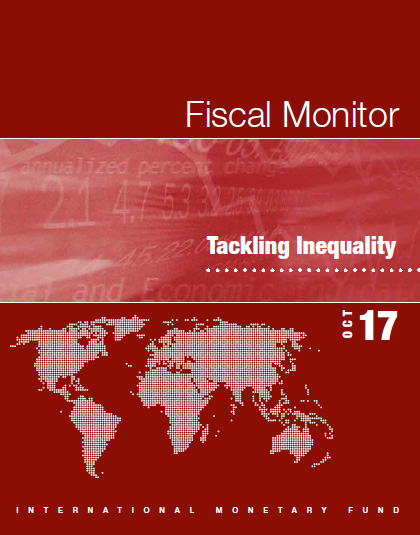 The latest edition of the IMF’s Fiscal Monitor, ‘Tackling Inequality’ challenges conventional wisdom that policies to reduce inequality will also reduce economic growth.
The latest edition of the IMF’s Fiscal Monitor, ‘Tackling Inequality’ challenges conventional wisdom that policies to reduce inequality will also reduce economic growth.
While some inequality is inevitable in a market-based economic system, excessive inequality can erode social cohesion, lead to political polarization, and ultimately lower economic growth.
The IMF looks at three possible policy alternatives to reduce inequality without damaging economic growth
The first is a rise in personal income tax rates for top earners. Since top rates have been cut in most countries, with the OECD average falling from 62% to 35% over the past 30 years, the IMF maintains that there is considerable scope of raising top rates, with the optimum being around 44%. Evidence suggests that income tax elasticity is low at most countries’ current top rates, meaning that a rise in top income tax rates would only have a small disincentive effect on earnings.
 An increased progressiveness of income tax should be backed by sufficient taxes on capital to prevent income being reclassified as capital. Different types of wealth tax, such as inheritance tax, could also be considered. Countries should also reduce the opportunities for tax evasion.
An increased progressiveness of income tax should be backed by sufficient taxes on capital to prevent income being reclassified as capital. Different types of wealth tax, such as inheritance tax, could also be considered. Countries should also reduce the opportunities for tax evasion.
The second policy alternative is a universal basic income for all people. This could be achieved by various means, such as tax credits, child benefits and other cash benefits, or minimum wages plus benefits for the unemployed or non-employed.
The third is better access to health and education, both for their direct effect on reducing inequality and for improving productivity and hence people’s earning potential.
In all three cases, fiscal policy can help through a combination of taxes, benefits and public expenditure on social infrastructure and human capital.
But a major problem with using increased tax rates is international competition, especially with corporation tax rates. Countries are keen to attract international investment by having corporation tax rates lower than their rivals. But, of course, countries cannot all have a lower rate than each other. The attempt to do so simply leads to a general lowering of corporation tax rates (see chart in The Economist article) – to a race to the bottom. The Nash equilibrium rate of such a game is zero!
Videos
 Raising Taxes on the Rich Won’t Necessarily Curb Growth, IMF Says Bloomberg, Ben Holland and Andrew Mayeda (11/10/17)
Raising Taxes on the Rich Won’t Necessarily Curb Growth, IMF Says Bloomberg, Ben Holland and Andrew Mayeda (11/10/17)
 The Fiscal Monitor, Introduction IMF (October 2017)
The Fiscal Monitor, Introduction IMF (October 2017)
 Transcript of the Press Conference on the Release of the October 2017 Fiscal Monitor IMF (12/10/17)
Transcript of the Press Conference on the Release of the October 2017 Fiscal Monitor IMF (12/10/17)
Articles
Higher taxes can lower inequality without denting economic growth The Economist, Buttonwood (19/10/17)
Trump says the US has the highest corporate tax rate in the world. He’s wrong. Vox, Zeeshan Aleem (31/8/17)
Reducing inequality need not hurt growth Livemint, Ajit Ranade (18/10/17)
IMF: higher taxes for rich will cut inequality without hitting growth The Guardian, Larry Elliott and Heather Stewart (12/10/17)
IMF Fiscal Monitor
IMF Fiscal Monitor: Tackling Inequality – Landing Page IMF (October 2017)
Opening Remarks of Vitor Gaspar, Director of the Fiscal Affairs Department at a Press Conference Presenting the Fall 2017 Fiscal Monitor: Tackling Inequality IMF (11/10/17)
Fiscal Monitor, Tackling Inequality – Full Text IMF (October 2017)
Questions
- Referring to the October 2017 Fiscal Monitor, linked above, what arguments does the IMF use for suggesting that the optimal top rate of income tax is considerably higher than the current OECD average?
- What are the arguments for introducing a universal basic income? Should this depend on people’s circumstances, such as the number of their children, assets, such as savings or property, and housing costs?
- Find out the details of the UK government’s Universal Credit. Does this classify as a universal basic income?
- Why may governments reject the IMF’s policy recommendations to tackle inequality?
- In what sense can better access to health and education be seen as a means of reducing inequality? How is inequality being defined in this case?
- Find out what the UK Labour Party’s policy is on rates of income tax for top earners. Is this consistent with the IMF’s policy recommendations?
- What does the IMF report suggest about the shape of the Laffer curve?
- Explain what is meant by tax elasticity and how it relates to the Laffer curve?
 In the last blog post, As UK inflation rises, so real wages begin to fall, we showed how the rise in inflation following the Brexit vote is causing real wages in the UK to fall once more, after a few months of modest rises, which were largely due to very low price inflation. But how does this compare with other OECD countries?
In the last blog post, As UK inflation rises, so real wages begin to fall, we showed how the rise in inflation following the Brexit vote is causing real wages in the UK to fall once more, after a few months of modest rises, which were largely due to very low price inflation. But how does this compare with other OECD countries?
In an article by Rui Costa and Stephen Machin from the LSE, the authors show how, from the start of the financial crisis in 2007 to 2015 (the latest year for which figures are available), real hourly wages fell further in the UK than in all the other 27 OECD countries, except Greece (see the chart below, which is Figure 5 from their article). 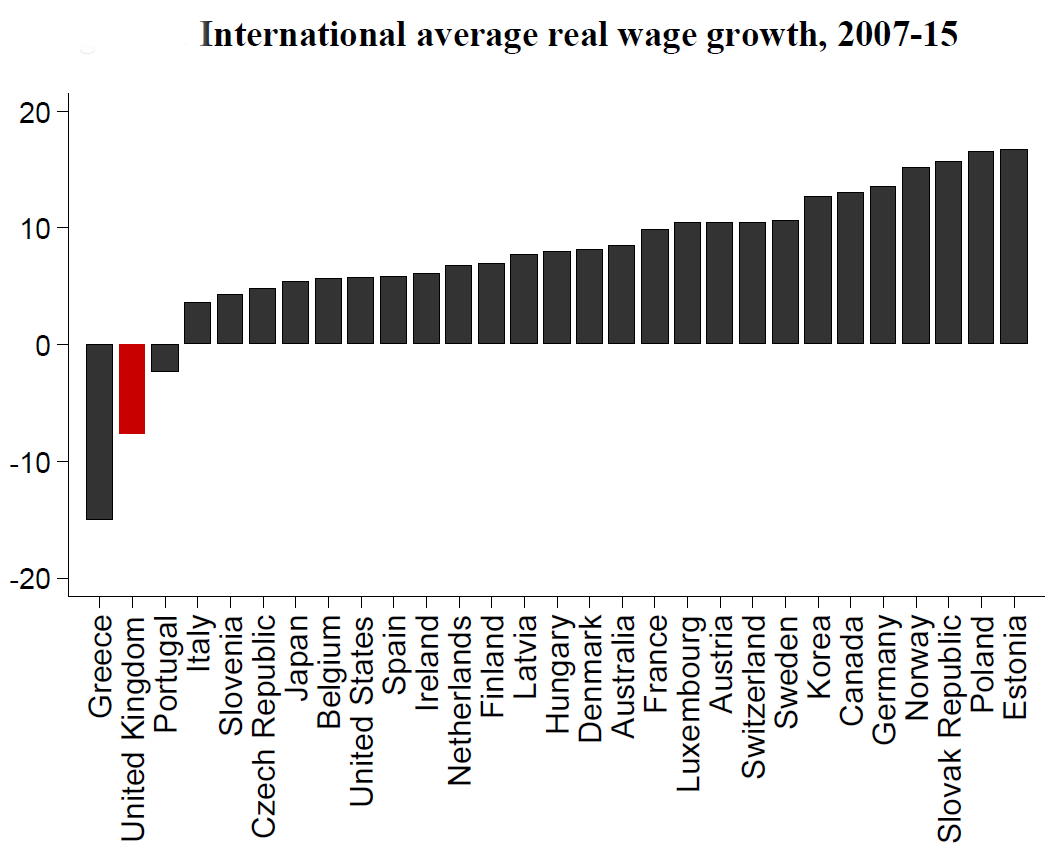 Indeed, only in Greece, the UK and Portugal were real wages lower in 2015 than in 2007.
Indeed, only in Greece, the UK and Portugal were real wages lower in 2015 than in 2007.
The authors examine a number of aspects of real wages in the UK, including the rise in self employment, differences by age and sex, and for different percentiles in the income distribution. They also look at how family incomes have suffered less than real wages, thanks to the tax and benefit system.
The authors also look at what the different political parties have been saying about the issues during their election campaigns and what they plan to do to address the problem of falling, or only slowly rising, real wages.
Articles
Real Wages and Living Standards in the UK LSE – Centre for Economic Performance, Rui Costa and Stephen Machin (May 2017)
The Return of Falling Real Wages LSE – Centre for Economic Performance, David Blanchflower, Rui Costa and Stephen Machin (May 2017)
The chart that shows UK workers have had the worst wage performance in the OECD except Greece Independent, Ben Chu (5/6/17)
Data
Earnings and working hours ONS
OECD.Stat OECD
International comparisons of productivity ONS
Questions
- Why have real wages fallen more in the UK than in all OECD countries except Greece?
- Which groups have seen the biggest fall in real wages? Explain why.
- What policies are proposed by the different parties for raising real wages (a) generally; (b) for the poorest workers?
- How has UK productivity growth compared with that in other developed countries? What explanations can you offer?
- What is the relationship between productivity growth and the growth in real wages?
 The French have elected Emmanuel Macron as their new President. He claims to be from the economic centre. But just what does this imply for his vision of how the French economy should be run? What policies is he likely to put in place? Can these policies rightly be described as ‘centrist’? In practice, some of his policies are advocated by the centre right and some by the centre left.
The French have elected Emmanuel Macron as their new President. He claims to be from the economic centre. But just what does this imply for his vision of how the French economy should be run? What policies is he likely to put in place? Can these policies rightly be described as ‘centrist’? In practice, some of his policies are advocated by the centre right and some by the centre left.
He wants to institute policies that are pro business and will have the effect of stimulating private investment, increasing productivity and resulting in faster economic growth.
His pro-business policies include: reducing corporation tax from its current 33.3% to 25%, the hope being that firms will invest the money that this will free up; reducing labour taxes on companies for employing low-wage workers; making the current 35-hour working week less rigid by giving firms greater ability to negotiate special arrangements with trade unions.
Other policies drawn from the centre right include reducing the size of the state. Currently, general government spending in France, at 56.5% of GDP, is the highest of the G7 countries. Italy’s is the next highest at 49.6%, followed by Germany at 44.3%, Canada at 40.8%, the UK at 39.4%, Japan at 36.8% and the USA at 35.2%. President Macron wants to reduce the figure for France to 52% over his five-year term.  This will be achieved by cutting 120,000 public-sector jobs and reducing state spending by €60bn. He plans, thereby, to reduce the general government deficit from its 2016 level of 3.4% of GDP to 1% by 2022 and reduce the general government debt from 96.0% of GDP to 93.2% over the same period.
This will be achieved by cutting 120,000 public-sector jobs and reducing state spending by €60bn. He plans, thereby, to reduce the general government deficit from its 2016 level of 3.4% of GDP to 1% by 2022 and reduce the general government debt from 96.0% of GDP to 93.2% over the same period.
Drawing from centre-left policies he plans to increase public investment by €50bn, including €15bn on training, €15bn on green energy and €5bn each on transport, health, agriculture and the modernisation of public administration. But as this additional expenditure is less than the planned savings through greater efficiency and as GDP is projected to grow, this is still consistent with achieving a reduction in the general government deficit as a percentage of GDP. He has also pledged to extend welfare spending. This will include making the self-employed eligibile for unemployment benefits.
M Macron isalso strongly supportive of France’s membership of the EU and the euro. Nevertheless he wants the EU to be reformed to make it more efficient and achieve significant cost savings.
Articles
Macronomy: What are Emmanuel Macron’s economic plans? BBC News, Simon Atkinson (8/5/17)
Factbox: Emmanuel Macron’s presidential election policies Reuters, Brian Love (14/4/17)
What Analysts Are Saying About Macron’s Victory Bloomberg, Chris Anstey (8/5/14)
The Main Points of Emmanuel Macron’s Economic Programme NDTV, India (9/5/14)
Can Emmanuel Macron solve France’s economic riddle? The Guardian, Larry Elliott (30/4/17)
Why Emmanuel Macron’s bid to haul France out of its economic malaise will be harder than he thinks The Telegraph, Szu Ping Chan and Tim Wallace (30/4/17)
Macron’s policies on Europe, trade, immigration and defence Financial Times, Hannah Murphy (7/5/17)
French presidential election: Investors, economists and strategists react to Macron’s victory Independent, Josie Cox (8/5/17)
Questions
- Compare the performance of the French, German and UK economies over the past 10 years.
- Why does France have much lower levels of inequality and much higher productivity than the UK?
- How would (a) a neoliberal and (b) Keynesian economist explain the slow growth performance of France?
- Give some other examples of centre-right economic policies that could be pursued by a centrist government.
- Give some other examples of centre-left economic policies that could be pursued by a centrist government.
- How do M Macron’s policies differ from those of the (a) Conservative, (b) Labour and (c) Liberal Democrat parties in the manifestos for the 2017 General Election in the UK?
- What economic difficulties is M Macron likely to find in carrying out his policies?
- Would you describe M Macron’s macroeconomic policies as demand-side or supply -side policies? Explain.
- What specific economic policies does France want Germany to pursue?
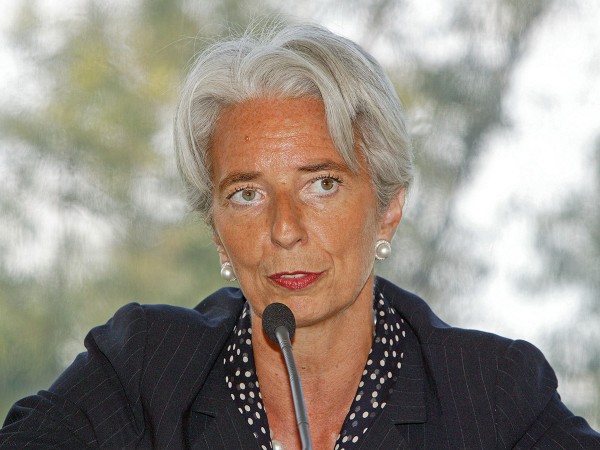 According to Christine Lagarde, Managing Director of the IMF, the slow growth in global productivity is acting as a brake on the growth in potential income and is thus holding back the growth in living standards. In a recent speech in Washington she said that:
According to Christine Lagarde, Managing Director of the IMF, the slow growth in global productivity is acting as a brake on the growth in potential income and is thus holding back the growth in living standards. In a recent speech in Washington she said that:
Over the past decade, there have been sharp slowdowns in measured output per worker and total factor productivity – which can be seen as a measure of innovation. In advanced economies, for example, productivity growth has dropped to 0.3 per cent, down from a pre-crisis average of about 1 per cent. This trend has also affected many emerging and developing countries, including China.
We estimate that, if total factor productivity growth had followed its pre-crisis trend, overall GDP in advanced economies would be about 5 percent higher today. That would be the equivalent of adding another Japan – and more – to the global economy.
So why has productivity growth slowed to well below pre-crisis rates? One reason is an ageing working population, with older workers acquiring new skills less quickly. A second is the slowdown in world trade and, with it, the competitive pressure for firms to invest in the latest technologies.
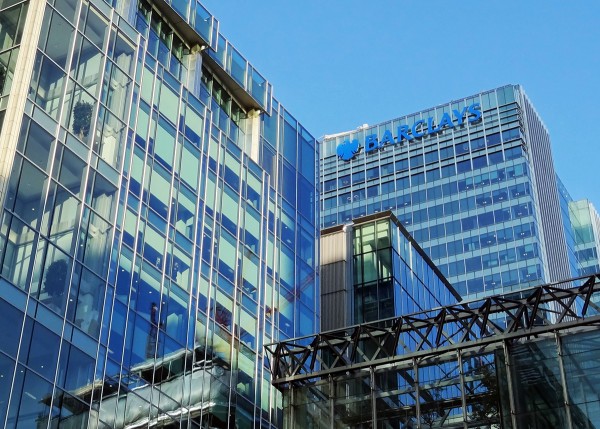 A third is the continuing effect of the financial crisis, with many highly indebted firms forced to make deep cuts in investment and many others being cautious about innovating. The crisis has dampened risk taking – a key component of innovation.
A third is the continuing effect of the financial crisis, with many highly indebted firms forced to make deep cuts in investment and many others being cautious about innovating. The crisis has dampened risk taking – a key component of innovation.
What is clear, said Lagarde, is that more innovation is needed to restore productivity growth. But markets alone cannot achieve this, as the benefits of invention and innovation are, to some extent, public goods. They have considerable positive externalities.
She thus called on governments to give high priority to stimulating productivity growth and unleashing entrepreneurial energy. There are several things governments can do. These include market-orientated supply-side policies, such as removing unnecessary barriers to competition, driving forward international free trade and cutting red tape. They also include direct intervention through greater investment in  education and training, infrastructure and public-sector R&D. They also include giving subsidies and/or tax relief for private-sector R&D.
education and training, infrastructure and public-sector R&D. They also include giving subsidies and/or tax relief for private-sector R&D.
Banks too have a role in chanelling finance away from low-productivity firms and towards ‘young and vibrant companies’.
It is important to recognise, she concluded, that innovation and structural change can lead to some people losing out, with job losses, low wages and social deprivation. Support should be given to such people through better education, retraining and employment incentives.
Articles
IMF chief warns slowing productivity risks living standards drop Reuters, David Lawder (3/4/17)
Global productivity slowdown risks social turmoil, IMF warns Financial Times, Shawn Donnan (3/4/17)
Global productivity slowdown risks creating instability, warns IMF The Guardian, Katie Allen (3/4/17)
The Guardian view on productivity: Britain must solve the puzzle The Guardian (9/4/17)
Speech
Reinvigorating Productivity Growth IMF Speeches, Christine Lagarde, Managing Director, IMF(3/4/17)
Paper
Gone with the Headwinds: Global Productivity IMF Staff Discussion Note, Gustavo Adler, Romain Duval, Davide Furceri, Sinem Kiliç Çelik, Ksenia Koloskova and Marcos Poplawski-Ribeiro (April 2017)
Questions
- What is the relationship between actual and potential economic growth?
- Distinguish between labour productivity and total factor productivity.
- Why has total factor productivity growth been considerably slower since the financial crisis than before?
- Is sustained productivity growth (a) a necessary and/or (b) a sufficient condition for a sustained growth in living standards?
- Give some examples of technological developments that could feed through into significant growth in productivity.
- What is the relationship between immigration and productivity growth?
- What policies would you advocate for increasing productivity? Explain why.
 In delivering his Budget on 22 November, Philip Hammond reported that the independent Office for Budget Responsibility had revised down its forecasts of growth in productivity and real GDP, and hence of earnings growth.
In delivering his Budget on 22 November, Philip Hammond reported that the independent Office for Budget Responsibility had revised down its forecasts of growth in productivity and real GDP, and hence of earnings growth. Although other countries’ productivity growth has also slowed since the financial crisis, it has slowed more in the UK and from a lower base – and is now forecast to rebound less quickly.
Although other countries’ productivity growth has also slowed since the financial crisis, it has slowed more in the UK and from a lower base – and is now forecast to rebound less quickly. Looking forward, the nature of the Brexit deal will impact on confidence, investment, wages and growth. If the deal is bad for the UK, the OBR’s forecasts are likely to be too optimistic. As it is, uncertainty over the nature of the post-Brexit world is weighing heavily on investment as some businesses choose to wait before committing to new investment.
Looking forward, the nature of the Brexit deal will impact on confidence, investment, wages and growth. If the deal is bad for the UK, the OBR’s forecasts are likely to be too optimistic. As it is, uncertainty over the nature of the post-Brexit world is weighing heavily on investment as some businesses choose to wait before committing to new investment. Autumn Budget 2017 Institute for Fiscal Studies (23/11/17)
Autumn Budget 2017 Institute for Fiscal Studies (23/11/17)








